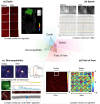This is a preprint.
Neurophotonics beyond the Surface: Unmasking the Brain's Complexity Exploiting Optical Scattering
- PMID: 38562443
- PMCID: PMC10984001
Neurophotonics beyond the Surface: Unmasking the Brain's Complexity Exploiting Optical Scattering
Update in
-
Neurophotonics beyond the surface: unmasking the brain's complexity exploiting optical scattering.Neurophotonics. 2024 Sep;11(Suppl 1):S11510. doi: 10.1117/1.NPh.11.S1.S11510. Epub 2024 Apr 12. Neurophotonics. 2024. PMID: 38617592 Free PMC article.
Abstract
The intricate nature of the brain necessitates the application of advanced probing techniques to comprehensively study and understand its working mechanisms. Neurophotonics offers minimally invasive methods to probe the brain using optics at cellular and even molecular levels. However, multiple challenges persist, especially concerning imaging depth, field of view, speed, and biocompatibility. A major hindrance to solving these challenges in optics is the scattering nature of the brain. This perspective highlights the potential of complex media optics, a specialized area of study focused on light propagation in materials with intricate heterogeneous optical properties, in advancing and improving neuronal readouts for structural imaging and optical recordings of neuronal activity. Key strategies include wavefront shaping techniques and computational imaging and sensing techniques that exploit scattering properties for enhanced performance. We discuss the potential merger of the two fields as well as potential challenges and perspectives toward longer term in vivo applications.
Keywords: brain probing; complex media; computational imaging; neurophotonics; wavefront shaping.
Conflict of interest statement
Disclosures The authors declare no conflicts of interest.
Figures



Similar articles
-
Neurophotonics beyond the surface: unmasking the brain's complexity exploiting optical scattering.Neurophotonics. 2024 Sep;11(Suppl 1):S11510. doi: 10.1117/1.NPh.11.S1.S11510. Epub 2024 Apr 12. Neurophotonics. 2024. PMID: 38617592 Free PMC article.
-
Wavefront shaping: A versatile tool to conquer multiple scattering in multidisciplinary fields.Innovation (Camb). 2022 Aug 2;3(5):100292. doi: 10.1016/j.xinn.2022.100292. eCollection 2022 Sep 13. Innovation (Camb). 2022. PMID: 36032195 Free PMC article. Review.
-
Roadmap on neurophotonics.J Opt. 2016 Sep;18(9):093007. doi: 10.1088/2040-8978/18/9/093007. Epub 2016 Aug 18. J Opt. 2016. PMID: 28386392 Free PMC article.
-
Disordered Optics: Exploiting Multiple Light Scattering and Wavefront Shaping for Nonconventional Optical Elements.Adv Mater. 2020 Sep;32(35):e1903457. doi: 10.1002/adma.201903457. Epub 2019 Sep 25. Adv Mater. 2020. PMID: 31553491 Review.
-
Photoacoustics with coherent light.Photoacoustics. 2016 Mar 4;4(1):22-35. doi: 10.1016/j.pacs.2016.01.003. eCollection 2016 Mar. Photoacoustics. 2016. PMID: 27069874 Free PMC article. Review.
References
-
- Kandel E. R. et al. Principles of neural science. vol. 4 (McGraw-hill; New York, 2000).
-
- Bear M., Connors B. & Paradiso M. A. Neuroscience: exploring the brain, enhanced edition: exploring the brain. (Jones & Bartlett Learning, 2020).
-
- Strangman G., Boas D. A. & Sutton J. P. Non-invasive neuroimaging using near-infrared light. Biol. Psychiatry 52, 679–693 (2002). - PubMed
-
- Villringer A. & Chance B. Non-invasive optical spectroscopy and imaging of human brain function. Trends Neurosci. 20, 435–442 (1997). - PubMed
Publication types
Grants and funding
LinkOut - more resources
Full Text Sources
